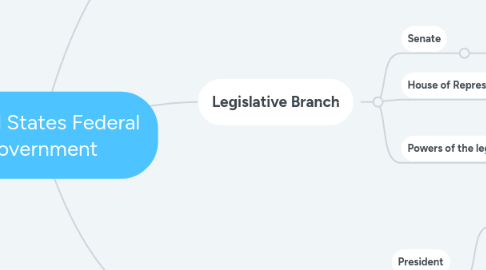
1. Judicial Branch
1.1. Supreme Court
1.1.1. The President nominates someone for a vacancy on the Court and the Senate votes to confirm the nominee, which requires a simple majority
1.1.1.1. no explicit requirements in the U.S. Constitution for a person to be nominated to become a Supreme Court justice
1.1.2. 9 justices:one Chief Justice and eight Associate Justices
1.1.2.1. Titled as Chief Justice
1.1.3. Court members can serve life
1.1.4. Rulings cannot be appealed
1.1.5. decides on cases dealing with the interpretation of the constitution
2. Legislative Branch
2.1. Senate
2.1.1. Senators are at least thirty years old and citizens for nine years.
2.1.1.1. 100 members in the Senate
2.1.1.1.1. Senators serve six-year terms and elections to the Senate are staggered over even years so that only about 1/3 of the Senate is up for reelection during any election
2.2. House of Representatives
2.2.1. House members must be twenty-five years of age and citizens for seven years
2.2.1.1. 435 members in the House of Representatives
2.2.1.1.1. Members of the House of Representatives serve two-year terms and are considered for reelection every even year
2.3. Powers of the legislative branch
2.3.1. Makes laws
2.3.2. Declares war
2.3.2.1. regulates interstate and foreign commerce and controls taxing and spending policies
3. Executive branch
3.1. President
3.1.1. a presidential candidate must be a natural born citizen of the United States, a resident for 14 years, and 35 years of age or older.
3.1.1.1. 4 year term
3.1.1.1.1. 2 term limit
3.1.2. Chief administrator
3.1.2.1. Chief of state
3.1.2.1.1. Chief legislator
3.1.2.1.2. Chief diplomat
3.1.2.2. Commander in chief
3.2. Vice President
3.2.1. be a natural-born U.S. citizen; be at least 35 years old; be a resident in the U.S. for at least 14 years.
3.2.1.1. 4 year term
3.2.1.1.1. 2 term limit
3.3. Powers of the executive branch
3.3.1. Being able to veto, or reject, a proposal for a law
3.3.1.1. Appoint federal posts, such as members of government agencies
3.3.1.1.1. Negotiate foreign treaties with other countries
3.3.1.2. Appoint federal judges.
3.3.1.2.1. Grant pardons, or forgiveness, for a crime

